Teaching Consonant Blends + Free Word List
This post may contain affiliate links. As an Amazon affiliate, we earn from qualifying purchases.
Learn all about teaching consonant blends or consonant clusters, with words and examples of initial l-blend, r-blend, s-blend, and w-blend words, ending t-blend and ending l-blend words, and 3 letter blend words.
As an added bonus, get a free printable list with 183 consonant blend words and examples, organized by blend.
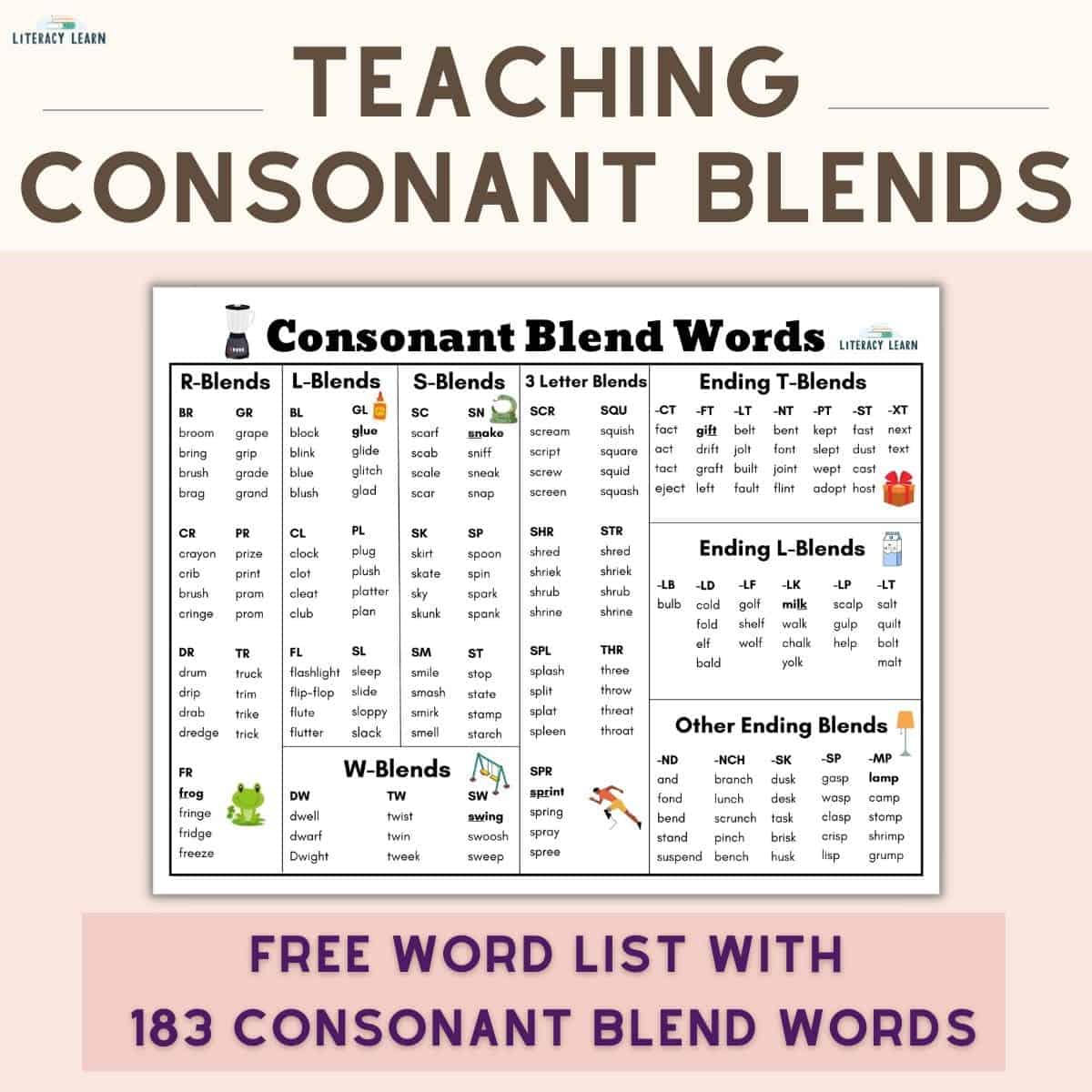
All About Consonant Blends
Consonant blends are two or three consonant letters next to each other, with no vowels in between. Each consonant sound (phoneme) can be heard in a consonant blend.
Blends are sometimes called consonant clusters because the consonants are clustered together with no vowels between.
These consonant clusters can come at the beginning of words (before the vowel) OR at the end of words (after a vowel). They can also be in the middle of a word when a prefix or suffix is added.
Teaching Consonant Blends
🥤I explain consonant blends like this to my students: When you make a smoothie in a blender, you might add blueberries and bananas and blend them together really fast. And when you take a sip, you should taste BOTH blueberries and bananas mixed together.
It’s the same ideas in consonant blends – except instead of tasting, we must hear each sound of the letters in the blend, saying them very fast.
👌 The great thing about blends is that we don’t have to teach them as separate units of sound. If students have a solid command of individual consonant sounds, then we can teach blends as a continuation of this.
Kids will need to focus on noticing the letters and matching those letters to sounds. Blends are usually introduced in first grade after letters a-z, short vowels, and digraphs and floss.
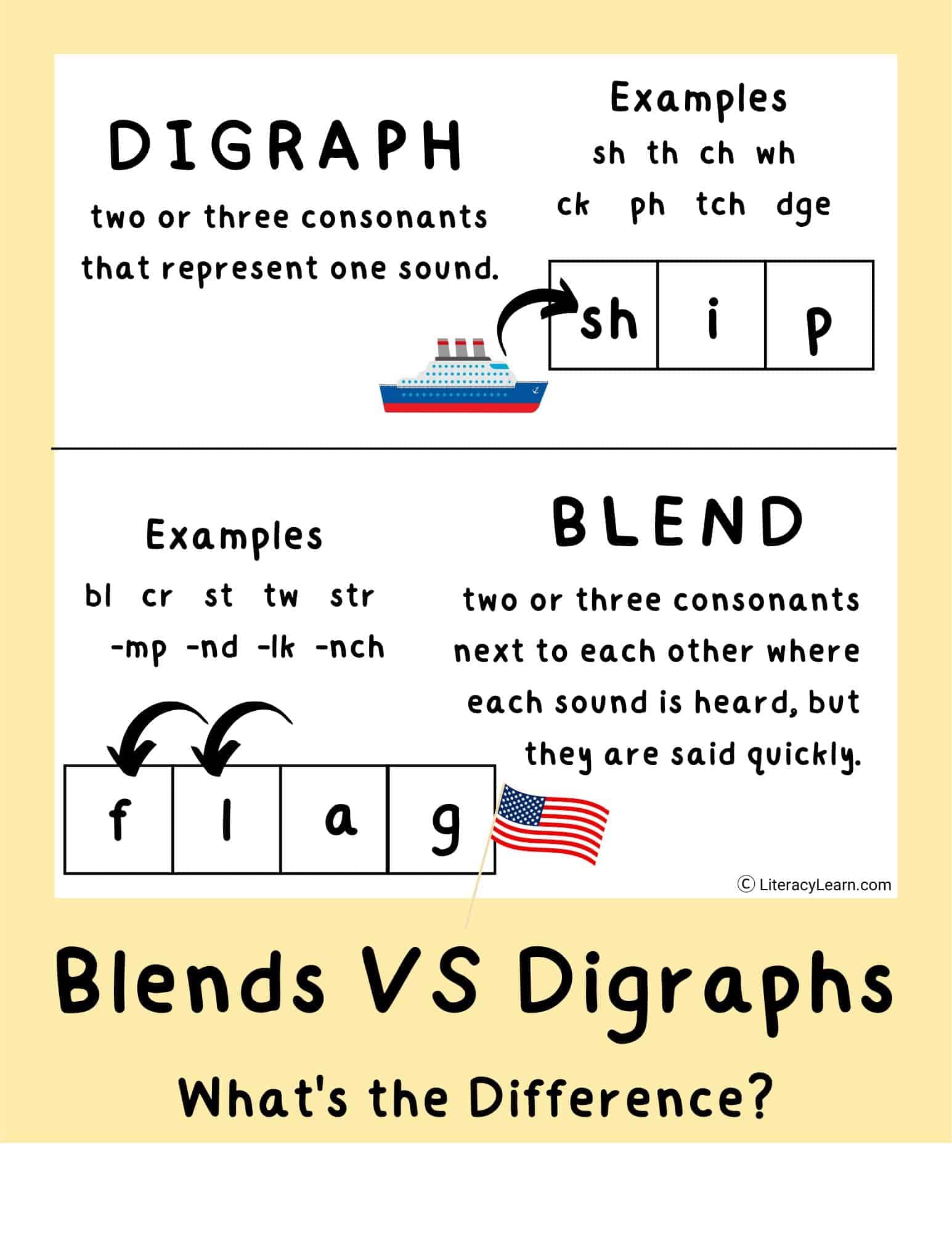
Blends Versus Digraphs
You might be wondering: What is the difference between blends and digraphs?
👉 Digraphs are two or three consonants that represent ONE sound (phoneme). Some examples include sh, ch, th, wh, ph, tch, and dge. (Read all about digraphs and grab a list of 161 digraph words.)
👉 Blends are two or three individual consonants (graphemes) that are next to one another and EACH separate sound (phoneme) can be heard. Some examples include cr, fl, st, sp, tw, str, -lt, and -ft.
It helps to show students examples of blends with pictures when teaching the difference!
Initial Consonant Blend Words
Initial consonant blends come at the beginning of words. Initial blends are usually sorted into three main categories: L blends, R blends, S blends. An additional category of W blends is sometimes included as well.
L-Blends
2 Consonant L-blend words include bl, cl, fl, gl, pl, and sl. The letter l is the second letter in the blend.
L-blend word examples:
| bl | cl | fl | gl | pl | sl |
| block | clock | flashlight | glue | plug | sleep |
| blink | clot | flip-flop | glide | plush | slide |
| blue | cleat | flute | glitch | platter | sloppy |
| blush | club | flutter | glad | plan | slack |
R-Blends
2 Consonant R-blend words include br cr, dr, fr, gr, pr, and tr. The letter r is the second letter in the blend.
R-blend word examples:
| br | cr | dr | fr | gr | pr | tr |
| broom | crayon | drum | frog | grape | prize | truck |
| bring | crib | drip | fringe | grip | trim | |
| brush | crush | drab | fridge | grade | pram | tricycle |
| brag | cringe | dredge | freeze | grand | prop | trick |
S-Blends
2 Consonant S-blend words include sc, sk, sl, sm, sn, sp, st, and sw. These blends start with the letter s.
S blend word examples:
| sc | sk | sm | sn | sp | st |
| scarf | skirt | smile | snake | spoon | stop |
| scab | skate | smash | sniff | spin | state |
| scale | sky | smirk | sneak | spark | stamp |
| scar | skunk | smell | snap | spank | starch |
W-Blends
Another smaller category can be consider ‘W’ blends, where the second letter in the blend is a W. 2 Consonant W-Blend words include dw, tw, and sw.
W-blend word examples:
| dw | tw | sw |
| dwell | twist | swing |
| dwarf | twin | swoosh |
| Dwight | tweek | sweep |
Final Consonant Blend Words
Ending blends are sorted into these categories: Ending T Blends, Ending L Blends, and Others ending blends.
Ending T-Blends
Final T Blends include -ct, -ft, -lt, -nt, -pt, -st, and -xt. All of these blends end in the letter t.
Ending t-blend word examples:
| -ct | -ft | -lt | -nt | -pt | -st | -xt |
| fact | gift | belt | bent | kept | fast | text |
| act | drift | jolt | font | slept | dust | next |
| tact | graft | built | joint | wept | cast | |
| eject | left | fault | flint | adopt | host |
*Note that -xt actually has three sounds, since the /ks/ sound of x has two phonemes.
Ending L-Blends
Final L Blends include -lb, -ld, -lf, -lk, -lp, and -lt. These blends have the letter l as the first letter of the ending blend.
Ending l-blend word examples:
| -lb | -ld | -lf | -lk | -lp | -lt |
| bulb | cold | golf | milk | scalp | salt |
| fold | shelf | walk | gulp | quilt | |
| wild | wolf | chalk | help | bolt | |
| bald | elf | yolk | malt |
Other Ending Blends
Other Ending Blends include -nd, -nk, -sk, -sp, and -mp. Below are some other ending blend word examples:
| -nd | -nch | -sk | -sp | -mp |
| and | branch | dusk | gasp | lamp |
| fond | lunch | desk | wasp | camp |
| bend | scrunch | task | clasp | stomp |
| stand | pinch | brisk | crisp | shrimp |
| suspend | bench | husk | lisp | grump |
Consonant Clusters with 3 Letters
The term consonant cluster is excellent, especially when describing blends that include three consonants. Anyone looking at these words can clearly see the cluster of consonants right next to one another.
3 Letter Blends examples include: scr, spl, spr, squ, and str.
| scr | shr | spl | spr | squ | str | thr |
| scream | shred | splash | spray | squish | strum | three |
| script | shreik | split | spree | square | straw | throw |
| screw | shrub | splat | sprint | squid | strong | threat |
| screen | shrine | spleen | spring | squash | strip | throat |
👉 Some blends can include a digraph. For example, the word shriek includes the digraph sh along with the consonant r.
These two sounds together form a consonant blend. Examples of blends with a digraph include: shr and thr.
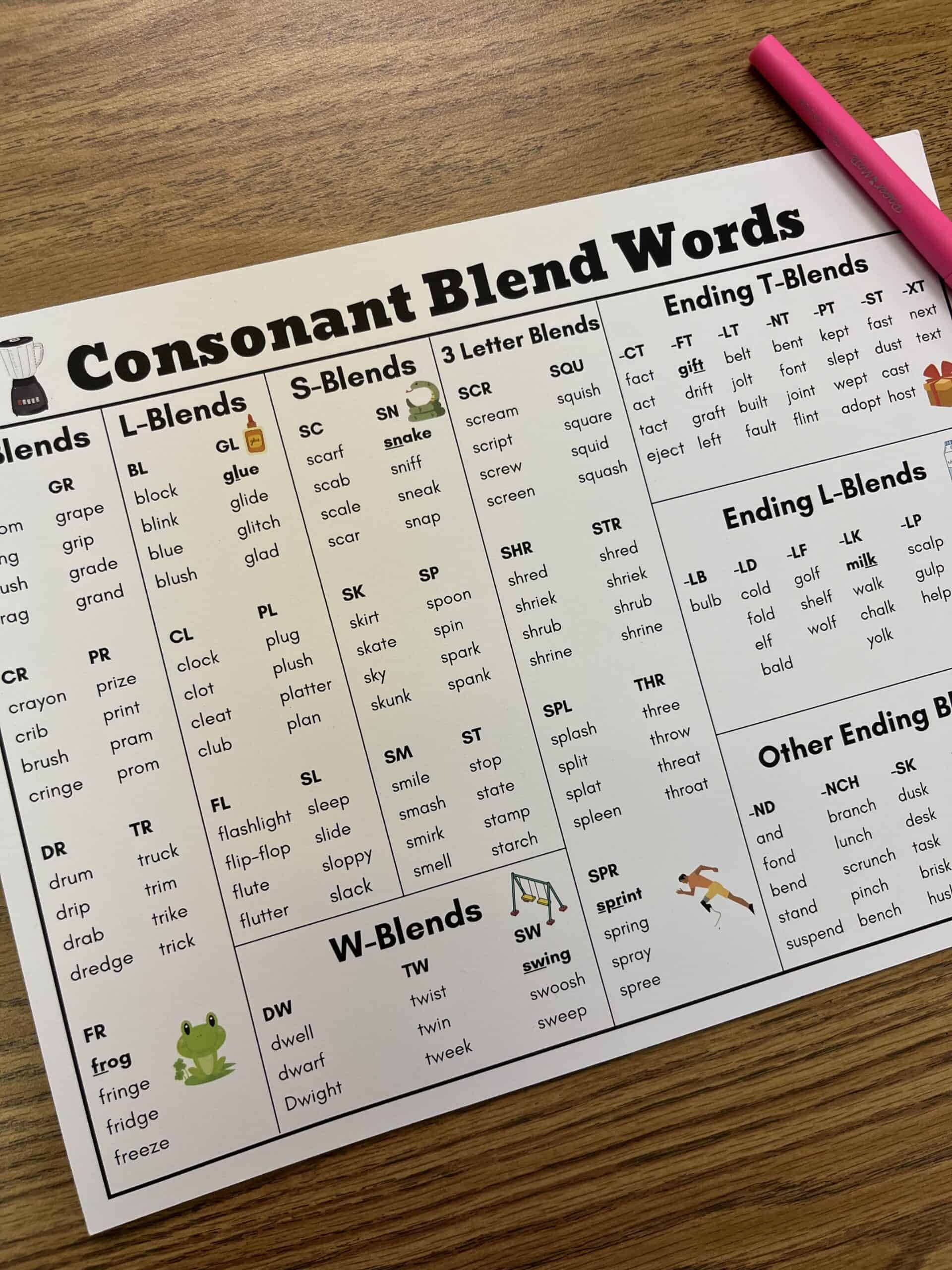
📃 Word List & Examples
Get this word list freebie where all blends are listed with examples! This one page freebie with 183 consonant blend words is great for so many things!
🧏🏼♂️ I especially like to use it for the auditory portion of my 3-part drill. For example, if I’m focused on initial R-blends, I’ll grab this worksheet and dictate a word from the r-blend column.
Kids listen for the blend they hear in the word and write the blend only. They should say the blend as they write it “B-R says /br/.”
💛 We love using it for the auditory portion of the lesson because kids don’t need to know advanced phonics skills in order to be able to practice with blends.
Remember, if you’re doing word dictation, be sure to only use words that include phonics features you’ve taught!
Related Resources
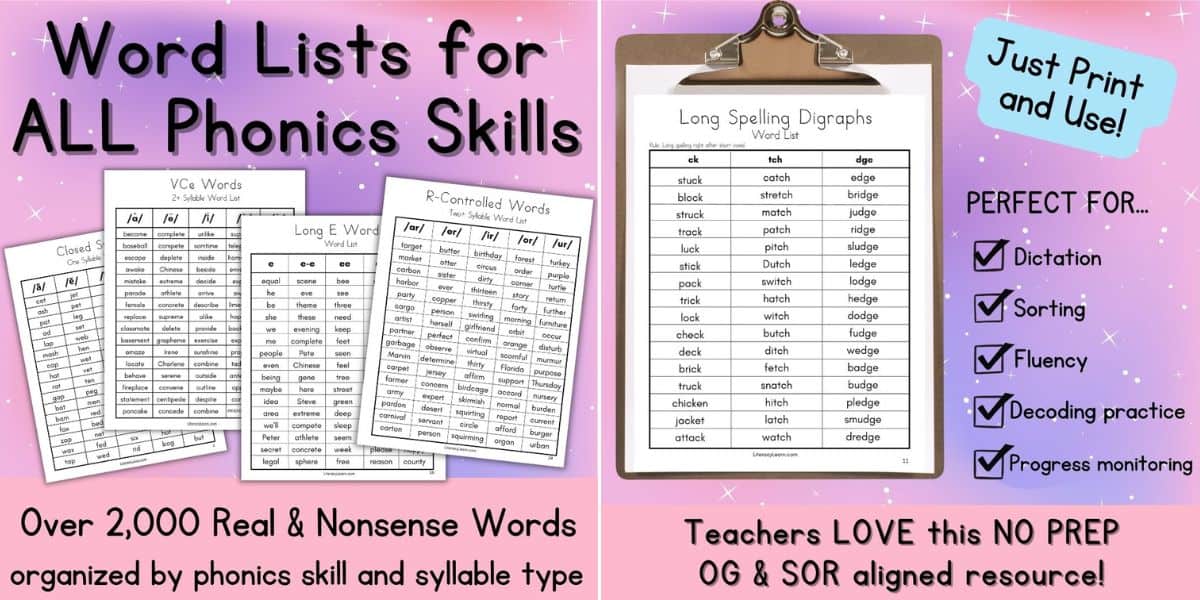
Download & Print
We’d love to hear about your experience with these worksheets!
Please leave a comment below or tag us on Instagram @literacylearn.
DOWNLOAD TERMS: All of our resources and printables are designed for personal use only in homes and classrooms. Each teacher must download his or her own copy. You may not: Save our files to a shared drive, reproduce our resources on the web, or make photocopies for anyone besides your own students. To share with others, please use the social share links provided or distribute the link to the blog post so others can download their own copies. Your support in this allows us to keep making free resources for everyone! Please see our Creative Credits page for information about the licensed clipart we use. If you have any questions or concerns regarding our terms, please email us. Thank you!

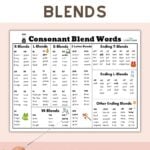


Hello from Russia! Thanks a lot for your amazing work!
Hi Anna,
We love knowing that people all around the world are utilizing our resources. Thank you for reaching out 😉
Katie and Laura
Hi Katie and Laura
Your explanations on BLENDS and DIAGRAPHS are excellent. I would like to get a little clarification. The word ‘campaign’ has two instances of two consonants next to each other. ‘mp’ and ‘gn’. In the pronunciation of the word, the letter ‘m’ is in the first syllable and ‘p’ in the second. So, is it correct to say that the ‘mp’ in this instant is not a BLEND? Also, of the ‘gn’, the ‘g’ is silent. Therefore, is it correct to consider the ‘gn’ NOT as a BLEND? Best wishes for the coming New Year – 2025. (greetings from SRI LANKA)
Hi Hasthi,
Thank you for your comment – all the way from Sri Lanka 🙂 It makes us so happy to know people from all over the world are finding us and learning more to help them in their literacy instruction.
If you go to etymonline, you can investigate the word origin – campaign comes from the French word ‘campogne.’ Usually, etymology (word origin) can explain spellings that don’t make sense to us. ‘gn’ is actually a digraph, not a blend. gn sounds like /n/ like gnat or sign. This is called a silent letter digraph. Also, I would not consider the -mp as blend in this word, since the syllable is divided between the blend cam/paign. I hope this makes sense!
Katie and Laura
Such a great resource! Your team does an amazing job of making this concise!
Thank you so much!
Hi Sarah, Thank you so much for the lovely feedback! We’re thrilled this resource is helpful for busy teachers like you! 🙂 -Katie & Laura
I have tried several times to access and print the freebies but have had no luck. How do I access these activities>
Hi Susan! Please send us an email and we’ll be happy to assist you! 🙂
It would be so helpful if those that subscribe to your email could actually download and print freebies as you describe on your website.
Hi Donna, We responded to your email a few weeks ago telling us you were confused about how to download our files, but we never heard back from you. You need to scroll to the “download and print” section, then click on the blue download button and follow the instructions. This resource has been downloaded thousands of times by other readers, and we’d be happy to help you learn how to do it easily! 🙂
For some reason I am having a hard time printing this…only half of the list will appear when I go to print..
Stevi,
So sorry about the issue you’re having with printing. Please try another browser. If you’re still having trouble, email us at literacylearnblog@gmail.com and we can help get this straightened out for you!
Katie & Laura
The consonant blend has an error with elf in the wrong column. Thanks for the chart. Its very useful.
Hi Karen,
It’s been corrected. Please feel free to download it again for the updated version. We are glad you are finding it useful.
Katie & Laura